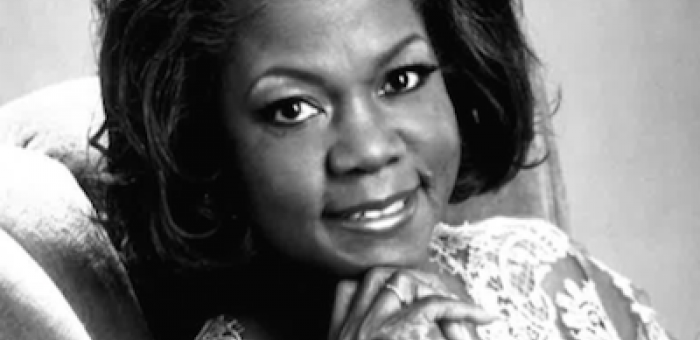Apr 2, 2024 12:59 PM
Saxophonist, Sonic Explorer Casey Benjamin Dies at 45
Casey Benjamin, the alto saxophonist, vocalist, keyboardist and producer who stamped his distinctive sounds on the…

Quincy Jones once described Ernestine Anderson’s voice as the “sound of honey at dusk.”
It was an accurate, evocative description of a vocalist whose career spanned six decades, including a performance at the first Monterey Jazz Festival in 1958, four Grammy nominations and a spot in the Smithsonian Institution’s “Jazz Singers” anthology. Anderson died March 10, at age 87.
Born in 1928, in Houston, Anderson began her professional career when she was 12, after winning a talent contest at Houston’s Eldorado Ballroom. She often said that this experience—which forced her to improvise because she gave the pianist the wrong key—made her realize she was a jazz singer.
In 1944, Anderson’s family moved to Seattle, where she became a fixture on Jackson Street’s after-hours scene, which included Jones, bassist Buddy Catlett and, later, Ray Charles. In 1947, Anderson went out on the road with Los Angeles r&b bandleader Johnny Otis.
“She was out with Johnny Otis and those bands before anybody,” Jones said. “Everyone was in awe of anybody that had gone on the road with a professional band.”
When Otis disbanded the group in Los Angeles, Anderson remained there, recording her first single, “K.C. Lover/Good Lovin’ Babe,” for the Black & White label. In 1952, she began a 15-month tour with Lionel Hampton, whose band at that time included Jones, trumpeter Clifford Brown and alto saxophonist Pony Poindexter and performed at the presidential inauguration of Dwight D. Eisenhower.
Moving to New York, Anderson worked at the Page Three, a nightclub where Sheila Jordan also sang. In 1955, Anderson appeared on two tracks of an album by alto saxophonist Gigi Gryce, Nica’s Tempo, which also featured trumpeter Art Farmer, with whom she later lived for several years.
The following year, Anderson went to Europe, where she recorded with bandleader Harry Arnold for the Metronome label. Championed by San Francisco jazz critic Ralph J. Gleason, Anderson’s album was picked up by Mercury and released in 1958. Hot Cargo netted rave reviews in Time magazine and The New York Times, where critic John S. Wilson compared her to Ella Fitzgerald, though her inspiration was Sarah Vaughan. Anderson’s singing was elegant and pure, with fastidious diction, and she swung effortlessly. The following year, she was toasted by DownBeat as a “new star.”
Anderson released six albums on Mercury. One of the best was Moanin’, Moanin’, Moanin, with its knockout version of “Come Rain Or Come Shine.” But by 1966, with the rock revolution in full swing, Anderson’s star fell and she retired from music.
Three years later, while living in L.A., she discovered Buddhist chanting, which she credited with lifting her out of a severe depression. In 1973, she was coaxed back to performing by Seattle jazz critic Maggie Hawthorn. Eventually managed by Ray Brown, Anderson signed with Concord Jazz. Hello, Like Before came out in 1977 and was followed by more than a dozen albums over the next 15 years, as well as tours in Japan, South America and Europe.
Singing in a more world-wise, raspier and blues-oriented style, Anderson took as her signature song a finger-popping blues recorded by B.B. King, “Never Make Your Move Too Soon.” During this period, Anderson could also still ring the bells of standard ballads like “Skylark” and “Old Folks.”
Anderson left Concord in 1993 and signed to Jones’ label, Qwest, which presented her in a soul-jazz mode, netting Grammy nominations and strong sales for Now And Then (1993) and Blues, Dues & Love News (1996).
Never a bestselling artist, Anderson was consistently praised by critics and was making well-reviewed albums after 2000. In 2015, High Note released a 1962 live recording from Seattle’s Penthouse nightclub, Ernestine Anderson Swings The Penthouse. The album was a keen reminder of how pure and moving Anderson’s voice had been in her early career.

Benjamin possessed a fluid, round sound on the alto saxophone, and he was often most recognizable by the layers of electronic effects that he put onto the instrument.
Apr 2, 2024 12:59 PM
Casey Benjamin, the alto saxophonist, vocalist, keyboardist and producer who stamped his distinctive sounds on the…

“He’s constructing intelligent musical sentences that connect seamlessly, which is the most important part of linear playing,” Charles McPherson said of alto saxophonist Sonny Red.
Feb 27, 2024 1:40 PM
“I might not have felt this way 30 to 40 years ago, but I’ve reached a point where I can hear value in what people…

Albert “Tootie” Heath (1935–2024) followed in the tradition of drummer Kenny Clarke, his idol.
Apr 5, 2024 10:28 AM
Albert “Tootie” Heath, a drummer of impeccable taste and time who was the youngest of three jazz-legend brothers…

“Both of us are quite grounded in the craft, the tradition and the harmonic sense,” Rosenwinkel said of his experience playing with Allen. “Yet I felt we shared something mystical as well.”
Mar 12, 2024 11:42 AM
“There are a few musicians you hear where, as somebody once said, the molecules in the room change. Geri was one of…

Larry Goldings’ versatility keeps him in high demand as a leader, collaborator and sideman.
Feb 21, 2024 10:45 AM
Are you having any fun? Larry Goldings certainly is. Consider just two recent examples:
Scene 1: “If anyone had…